Japan Wood Products
Prices
Dollar Exchange Rates of 10th
October 2015
Japan Yen 119.74
Reports From Japan
Fall in consumer confidence raises risk to
economy
The latest Consumer Confidence survey results have been
released by Japan‟s Cabinet Office.
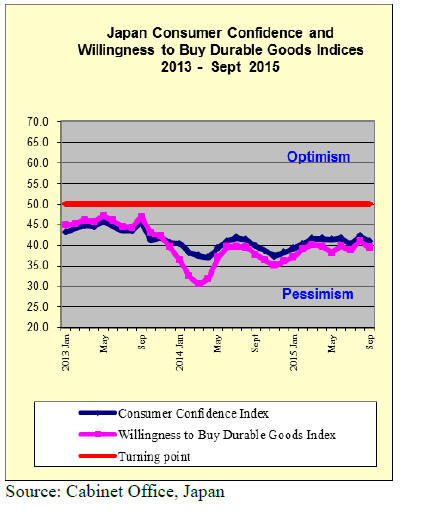
The latest survey shows consumer confidence in
September weakened more than forecast. The overall
consumer confidence index fell to 40.6 in September from
41.7 in August.
This survey was conducted on September 15th, 2015 and
covered 8,400 households.
The overall livelihood index in September stood at 38.8,
down from the previous month; the income growth index
stood at 39.4, also down from a month earlier.
The downward trend continued with the employment
index (44.9. down 1.4 points) and the willingness to buy
durable goods index (39.1.down 1.2 points month on
month).
TPP implementation a challenge for Japan’s agri and
timber sectors
The Japanese government has said it will introduce new
measures to support the country‟s agricultural sector
which will be affected by the TPP the trade agreement
which lowers tariffs in the 12 signatories countries. Japan
is set to eliminate import tariffs on over 800 agricultural
and wood products.
On the TPP the Japan Lumber Reports writes:
“Broad agreement has been reached by 12 participating
countries on Trans-Pacific Partnership (TPP). On lumber
and plywood, it is agreed that Japan can set up safeguard
and duty abolishment period in 16 years for the countries
from which import amount is large or growth of import is
remarkable. Such countries are Malaysia, New Zealand,
Canada, Chile and Vietnam. Also it is agreed to control
trade of illegal harvested wood.
On main items from Canada and Malaysia, Japan can
maintain safeguard even after the tariff is abolished. There
is no previous case in the world of setting safeguard on
forest products which are not agricultural products.
In case of Malaysian plywood, import duty rate will be
reduced from 6-10% to 3-5% in 16 years after the
agreement is ratified but if the volume reaches to a certain
level, the duty rate is automatically raised to the rate
before the ratification (1,044,000 cbms at the time of
ratification then 20,900 cbms increase every year and
31,300 cbms increase every year after 16 years).
For Canadian SPF lumber the import duty will be reduced
from 4.8% to 2.4% until 16 years after the ratification but
if the import volume reaches a certain level, the previous
duty rate before the ratification is applied (1,573,000
cbms at the time of ratification then 31,500 cbms increase
every year and 31,500 cbms increase after 16 years).
Duty on OSB, which substitutes plywood and lumber, will
be abolished step by step.
Meantime, on export of logs and lumber from Japan, main
destination of Taiwan, Korea and China do not participate
in the TPP.
The Japanese government announced in March 2015
‘Uniform calculation of economic effect in case import
duty is abolished’. In this, production value of forest
products will decline by about 49 billion yen by reduction
of duty and domestic products would be replaced by the
imports and resolution was made that utmost
consideration is necessary for import of plywood and
lumber.”
Tokyo property attracting overseas investors
Land prices in central Tokyo increased by just over 2% in
the first seven months of this year, a faster rate than
reported for the same period last year according to a report
from Japan‟s Ministry of Land, Infrastructure, Transport
and Tourism
However, residential land prices in Tokyo are still less
than 60% of what they were during Japan‟s property
bubble in the late 1980s.
See: http://tochi.mlit.go.jp/english/land-prices/landmarket-
value-publication
Property prices in Tokyo have been rising since the
government and Bank of Japan introduced measures to
tackle deflation. The relatively low house prices in Tokyo
compared to Hong Kong and even Shanghai for example
are attracting Chinese buyers looking for bargains while
the yen exchange rate remains favourable.
The recent downturn in stock values in China is prompting
investors to put money into „bricks and mortar” as a safe
haven.
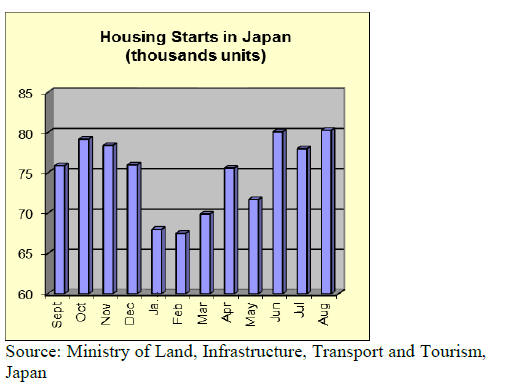
Yen remains under pressure
Expectations that the Bank of Japan (BoJ) could expand
the scope of its monetary easing policy sometime this
month put a downward pressure on the yen/dollar
exchange rate reversing the modest advance of the yen
early in the month.
At its latest meeting the BoJ maintained its policy but kept
open the avenue for further stimulus to try and reverse the
downward trend in growth.
In related news, Cabinet Office data for August machinery
orders show a decline of 5.7% from July in contrast to the
forecast rise. The drop in orders in August was the third
consecutive monthly decline and it was as long as 6 years
ago that the situation was worse.
Two factors have been quoted as being the cause of the
fall in machinery orders, slow growth in China and
weakening domestic demand.
In a separate report the Bank of Japan (BoJ) said that it is
now seeing an excess of manufacturing capacity with the
difference between available resources and their utilisation
fell below zero. This heralds a period of deflation which is
a major set-back for the BoJ as it tries to generate an
inflationary pressure in the economy.
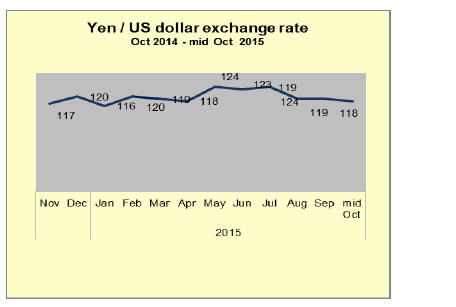
Doors
August 2015 imports of wooden doors were down on
levels reported for July but were similar to the value of
imports in August 2014.
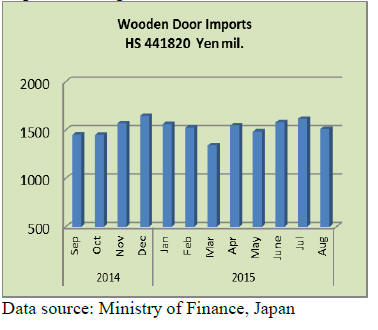
August is a holiday month in Japan and construction
companies close for almost two weeks. In the first 8
months of 2015 wooden door imports fell 11.5%
compared to the same period in 2014.
China and the Philippines continue as the top wooden door
suppliers accounting for just over 75% of Japan‟s August
imports of this product.
Windows
In the 8 months to August 2015 wooden window imports
were down 25% year on year. August 2015 imports were
sightly up on July but down sharply compared to the
value of imports in August 2014.
China continues as the number one supplier followed by
the Philippines and the US. The top three supplires
accounted for over 80% of all wooden window imports in
August.
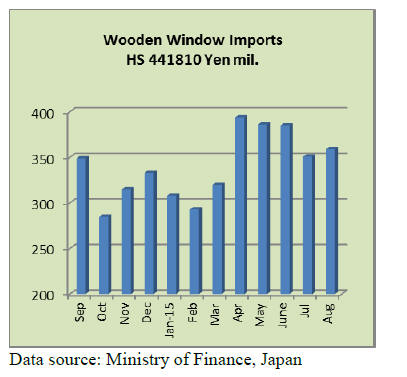
Assembled flooring
Japan‟s imports of assembled wooden flooring continued
the downward trend that began in July. August 2015
imports of assembled wooden flooring were down 40%
from the peak in June and were down 27% from July.
In the 8 months to August 2015 assembled wooden
flooring imports were down 28% compared to the same
period in 2014.
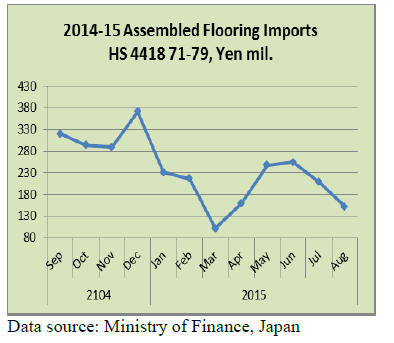
Plywood
Japan‟s August plywood imports were down 13% from a
month earlier continueing the downward trend that began
in April this year. In the 8 months to August this year
plywood imports from all sources were down 28%
compared to the same period in 2014.
Over the 8 months since Janaury 2015 the three main
suppliers: Malaysia, Indonesia and China have all seen
plywood demand in Japan wither. Over the first 8 months
plywood imports from Malaysia have fallen 10%, by 22%
for Indonesia and by 33% for China.

Trade news from the Japan Lumber Reports (JLR)
For the JLR report please see:
http://www.n-mokuzai.com/modules/general/index.php?id=7
Improved wood self-sufficiency rate
The Forestry Agency disclosed supply and demand of
wood in 2014. Total demand of wood including wood chip
for biomass fuel, wood for charcoal, wood for export is
75,814,000 cbms for which domestic production is
23,662,000 cbms so a degree of self-sufficiency is 31.2%.
This is the first time that the degree recovered over 30% in
26 years since 1988. The domestic demand declined
because of decrease of new housing starts but wood for
biomass fuel and wood export increased largely.
Plywood
Domestic softwood plywood market is firmly holding in
Tokyo market but demand and supply vary by the area.
Since late August, orders from wholesale channels slowed
down but deliveries for large house builders and precutting
plants are increasing.
Therefore, August shipment was 222,400 cbms, 15.1%
more than August last year while the production was
198,500 cbms, 0.5% less so that the inventories dropped
down to 159,600 cbms, 23,000 cbms less than July
inventory.
However, many think large volume of manufacturers‟
inventory shifted from manufacturers hand to distribution
channels so the market is calming from panic buying.
Many manufacturers still suffer delay of delivery and
shortage of some items. In Hokkaido with fair weather,
speculative demand showed up for fall demand pickup so
there is shortage of softwood plywood supply.
The market in August and September was dull as sales
volume dropped by 20-30%. Trading firms and
wholesalers disposed of some of their inventories before
book closing for the month of September but the sales
were so slow and the volume was very limited.
August arrivals were 205,200 cbms, 17% less than August
last year and 11.9% less than July, which was record low
since September 2011. September arrivals are as low as
August but there is no shortage feeling in the market.

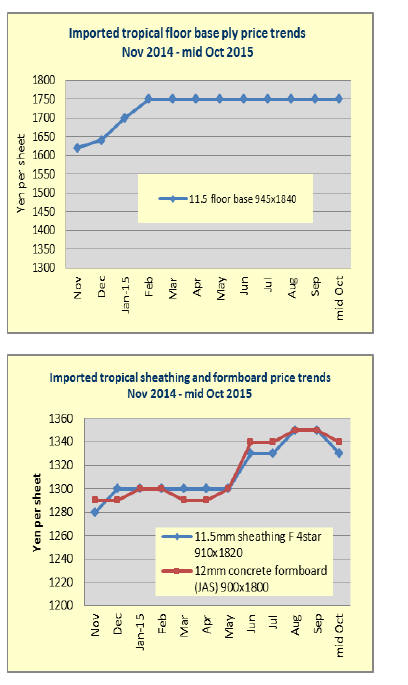
|